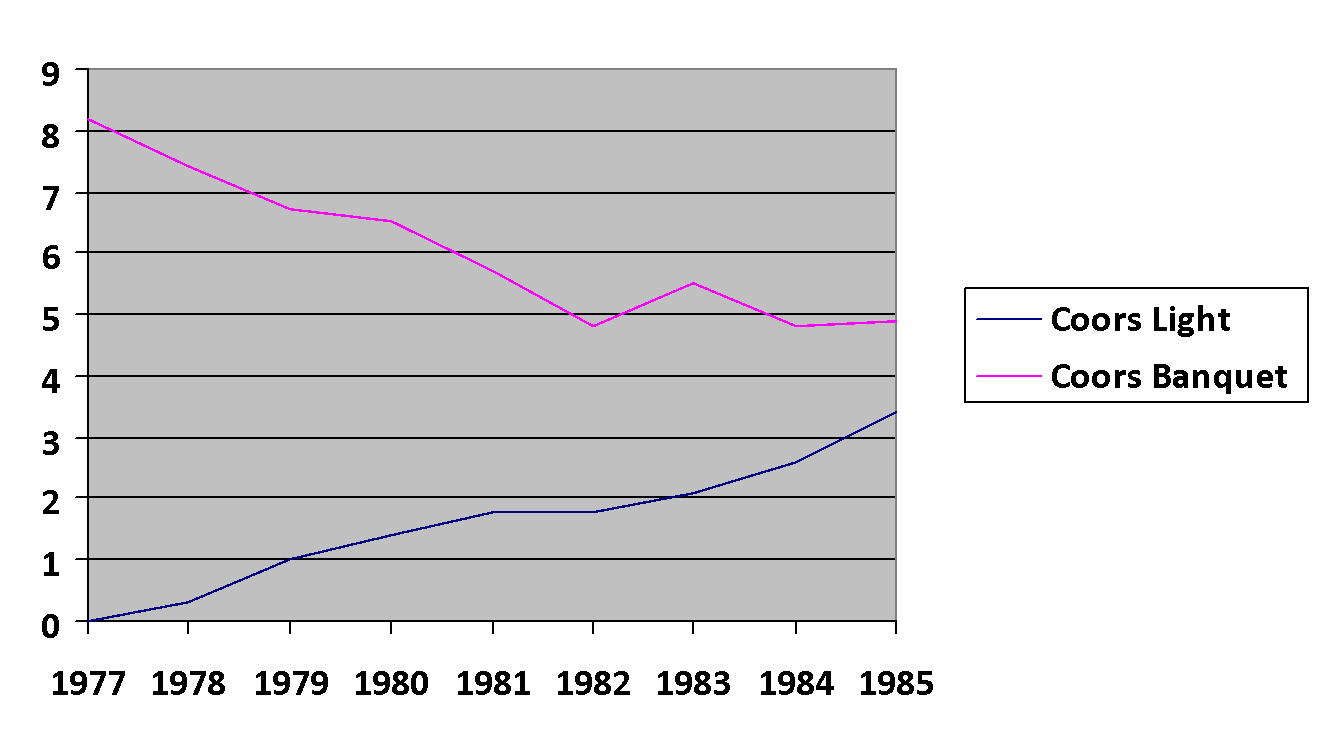Introduction
Analyzing the stories of companies’ successes is as important as studying the cases of failing companies because they demonstrate how the company’s approach to market conditions can produce successful decisions. In the case of Coors’s activity in the brewing industry, successful decisions that differentiated the company from competitors have served as the basis for the competitiveness and financial stability of the company. Thus, the company achieved success despite its controversial reputation and non-standard approach to market conditions and distribution policies. This case analysis will study Coors’s competitive position in the U.S. brewing industry to identify which factors contributed to the deterioration of the company’s competitiveness and define how the company can improve its future prospects.
Discussion
Firstly, to identify which factors caused the deterioration of Coors’s competitive position between the 1970s and 1980s, one should start by examining the data from the overall brewing industry. The early 1970s were characterized by significant shifts in the industry due to the transition to an integrated production and packaging system (Ghemawat, 1992). Thus, only large brewers who could afford rapid and aggressive expansion were able to benefit from the growing demand for beer.
Furthermore, the information featured in the case details connected the growth in the demand for beer products with the growing up of the baby boomer generation. The data also explains that young drinkers contributed to a significant portion of beer consumers in the U.S. as the young population generally tends to drink in larger volumes than the other adults (Ghemawat, 1992). Coors’s primary label, Banquet, positioned itself as a beer from the premium segment and had a significantly higher price due to the peculiarities of production and transportation.
Thus, considering that products from other large brewers were much cheaper, Coors’s sales were low because their premium label was unaffordable for a significant portion of the consumers in the face of young drinkers. Adding the cheaper Light brand of the original Coors Banquet beer, which was more appealing to young drinkers, allowed the company to benefit from a higher consumption rate in this audience segment (Figure 1).

Furthermore, the company’s emphasis on beer quality prevented Coors from implementing pasteurization processes. While other brewers were able to produce a high quantity of beer with a long shelf life, Coors’s activity for a long time focused on the quick distribution of newly produced beer. Even though the company’s focus on quality ultimately brought popularity to the brand, the competing companies had more opportunities to develop production, technology, and distribution channels at that time. Thus, by excessively focusing on the quality of the product and refusing to follow market trends, the company has significantly reduced its competitive position in the industry.
Next, considering the possible measures Coors can take to improve its future prospects, the company has already taken significant steps to minimize external influences on production. For example, a third of the raw materials used by the company in the brewing process are sourced from proprietary strains of barley grown by farmers in a long-term contract. Moreover, the company utilizes its own transportation network from refrigerated trucks and cars.
The company can maximize the capitalization of available resources by proposing mutually beneficial contracts to other manufacturers. For example, off-premise retail outlets for beer in supermarkets and grocery stores became more profitable in 1985 (Ghemawat, 1992). Moreover, the distribution of beer through wholesalers presents a time-consuming process that leaves little time for selling perishable products. Thus, by making direct contracts for the supply of beer with grocery store chains, the company can take full advantage of the available transport and access wider distribution channels with guaranteed storage conditions.
Furthermore, the multisite expansion primarily targets the reduction of transportation costs of shipping beer to the East Coast; however, the decision required additional financing from external resources. In addition, Coors’s price policy in the eastern market positioned the Banquet premium brand closer to Budweiser, even though Banquet was priced below Budweiser in the west. In order to justify the price and maintain it on the same level even after expansion to Rockingham County, Coors must create a sophisticated advertising plan. In the past, a creative approach to advertising has allowed the company to distinguish its product from competitors and gain substantial market share. Thus, a massive advertising campaign with invited celebrities will enable the company to associate its products with a more expensive lifestyle and higher quality standards.
Conclusion
In conclusion, this case analysis explained why Coors experienced significant difficulties maintaining its competitive position in the brewing industry between the 1970s and 1980s. The analysis defined that Coors’s lack of competitiveness was associated with the product’s high price, making it unaffordable for a significant portion of consumers. Moreover, competitors who used an easier and faster way of production quickly took a large share of the market. While the case demonstrates the importance of priorities in production, it also showcases how companies that go against market trends can still succeed even though it takes them longer to catch up with competitors.
Reference
Ghemawat, P. (1992). Adolph Coors in the brewing industry. Harvard Business School.